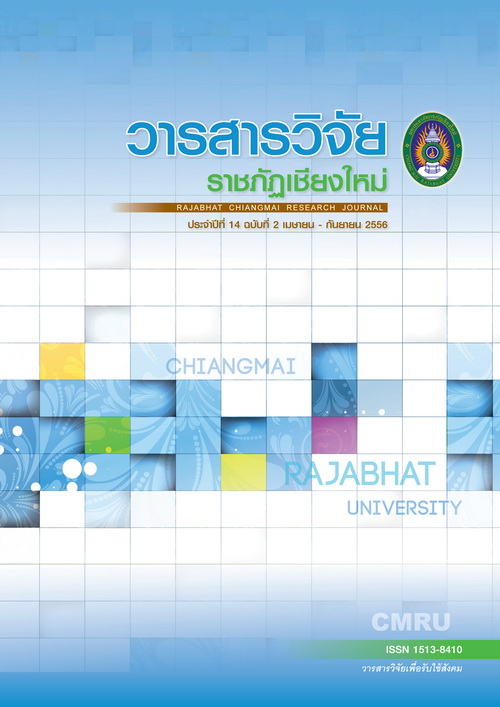อาทารไทลื้อในมิติทางประวัติคาสตร์และคุณค่าทางโภชนาการ
DOI:
https://doi.org/10.14456/rcmrj.2013.96154Keywords:
ไทลื้อ, คาร์โบไฮเดรต, โปรตีน, ไขมัน, วิตามินเอ, แคลเซียม, Tai Lue, Carbohydrate, Protein, Fat, Vitamin A, CalciumAbstract
การศึกษาเรื่อง อาหารไทลื้อในมิติทางประวัติศาสตร์และคุณค่าทางโภชนาการ มีวัตถรุประสงค์ (1) เพื่อศึกษาเส้นทาง การอพยพของซาวไทลื้อจากสิบสองพันนาสู่ล้านนา (2) เพื่อศึกษาวิธีการปรุงอาหาร ชนิดและประเภทของอาหารไทลื้อ และ (3) เพื่อศึกษาคุณค่าทางโภชนาการของอาหารไทลื้อ ในสิบสองพันนาและในล้านนา ผู้วิจัยทำการเก็บข้อมลเซิงคุณภาพโดยทำการสัมภาษณ์กลุ่มผู้ให้ข้อมูลหลัก ผลการศึกษา พบว่า เส้นทางการอพยพของซาวไทลื้อมีเส้นทางการอพยพจากหลายเมืองและเดินทางเข้าสู่ล้านนาหลายครั้ง โดยในครั้งแรกเดินทางเข้ามาเมื่อประมาณ 600 กว่าปี ในช่วงที่ 2 เดินทางจากเมืองต่างๆ เข้ามาในล้านนาในระยะเวลา 200 กว่าปี เส้นทางและช่วงเวลาของการอพยพมืผลต่ออาหารในแต่ละท้องถิ่น อาหารไทลื้อในเขตล้านนาและในเขตสิบสองพันนา มีกรรมวิธีการทำอาหาร การใช้เครื่องปรุง การรับประทาน การเสิร์ฟ การใช้อุปกรณ์และวัตถุดิบ ที่ยังมีร่องรอยให้ทำการเปรียบเทียบถึงความเหมือนและความแตกต่างกัน ประเภทและชนิดของอาหารมีการจัดกลุ่มใกล้เคียงกัน ส่วนการเรียกซื่อของอาหารและวิธีการทำ บางคำมีความแตกต่างกัน สำหรับในด้านคุณค่าทางโภชนาการ พบว่าอาหารที่ให้พลังงานสูง และมีปริมาณคาร์โบไฮเดรตมาก รวมทั้งมีไขมันสูง ได้แก่ ไก และอาหารที่ให้ปริมาณโปรตีนและแคลเซียมสูง ได้แก่ น้ำปู๋ อาหารที่ให้วิตามินเอสูง ได้แก่ น้ำปู๋ ส่วนอาหารที่มีปริมาณเบต้าแคโรทีนสูง ได้แก่ ไก
TAI LUE FOOD: HISTORY AND NUTRITIVE VALUE
The objectives of this study were to investigate migration routes of the Lue ethnic group from Xishuangbanna to the Lanna Region, and to examine the ethnic food types and their nutritive values in the two regions. The data on migration routes and types of foods were collected by interviewing key informants. The findings reveal that the migrations to the Lanna region originated from many towns and at different times. The first migration took place over 600 years ago. The second migration took place over 200 years ago. The investigation reveals that migration routes and periods of migration impacted on the diet in different localities. These two factors might be a major cause in the variation of the ethnic foods in Chiang Kham and Doi Saket Districts. As for the food, there are traces of similarities and of differences in cooking methods, ingredients, eating and serving styles, utensils, and raw materials. Additionally,food types, names and ingredients are very similar. Regarding the nutritive values of the food, it is found that the food consisting of high energy, carbohydrate and fat was kai and high protein and calcium was crab paste. The dish with vitamin A was crab paste and beta-carotene was kai.
Downloads
Downloads
How to Cite
Issue
Section
License
1. Articles, information, content, images, etc published in the “Community and Social Development Journal” are copyrighted by the Community and Social Development Journal, Chiang Mai Rajabhat University. In order to properly distribute the articles through print and electronic media, the authors still hold the copyright for the published articles under the Creative Commons Attribution (CC BY) license, which allows the re-distribution of the articles in other sources. References must be made to the articles in the journal. The authors are responsible for requesting permission to reproduce copyrighted content from other sources.
2. The content of the articles appearing in the journal is the direct responsibility of the article authors. The editorial board of the journal does not necessarily agree with or share any responsibility.














